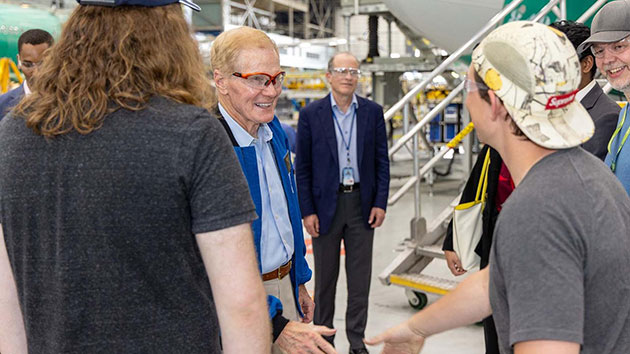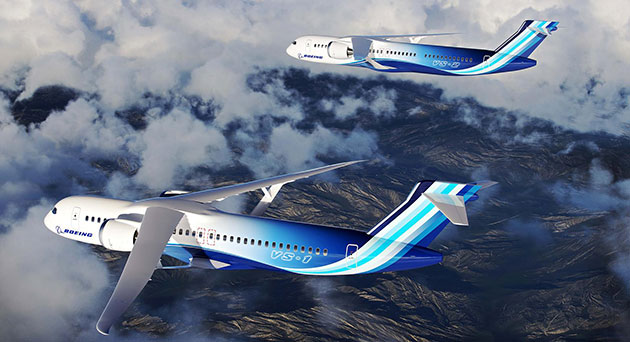NASA administrator impressed with Boeing X-plane design
Boeing’s X-66A will be the first of its kind aimed toward achieving the goal of net-zero aviation greenhouse emissions
 NASA Administrator Bill Nelson speaks with members of the 737 team on the floor of the factory in Renton, Washington. (Michael Holly photo)
NASA Administrator Bill Nelson speaks with members of the 737 team on the floor of the factory in Renton, Washington. (Michael Holly photo)
NASA Administrator Bill Nelson came away excited by Boeing’s in-depth presentation on the X-66A, an advanced, sustainability-focused airplane concept the company will build as part of NASA’s Sustainable Flight Demonstrator (SFD) program.
Todd Citron, chief technology officer, and Mike Sinnett, vice president and general manager, Commercial Product Development, briefed Nelson and showed him a model of the X-66A. Nelson also toured the 737 factory and met with members of the 737 team.
Their meeting follows the recent news that the U.S. Air Force has designated the SFD its next “X-plane,” expected to begin flight-testing in 2028.
 The transonic truss-braced wing design, when combined with other advancements in propulsion systems, materials, and systems architecture, could achieve up to a 30% reduction in fuel consumption and emissions. (Boeing image)
The transonic truss-braced wing design, when combined with other advancements in propulsion systems, materials, and systems architecture, could achieve up to a 30% reduction in fuel consumption and emissions. (Boeing image)
Why it matters: The technologies demonstrated and tested on the X-66A as part of the SFD program will inform future designs and could lead to groundbreaking aerodynamics and fuel efficiency.
- The transonic truss-braced wing (TTBW) design, when combined with other advancements in propulsion systems, materials, and systems architecture, could achieve up to a 30% reduction in fuel consumption and emissions.
- This is the first X-plane specifically focused on helping the U.S. achieve the goal of net-zero aviation greenhouse gas emissions.
What they’re saying:
- “The X-66A shows a lot of promise,” Nelson said. “NASA and Boeing are taking sustainable aerospace technology to new heights, while humanity and the environment see tremendous benefits.”
- “The X-66A concept is the product of years of homework done in conjunction with NASA,” Citron said. “This aircraft can be a leader in advancing numerous technologies while helping to decarbonize aerospace.”
 NASA Administrator Bill Nelson (center) tours the 737 factory with (from left) Todd Citron, chief technology officer; Mike Sinnett, vice president and general manager, Commercial Product Development; and Ed Clark, vice president and general manager, 737
NASA Administrator Bill Nelson (center) tours the 737 factory with (from left) Todd Citron, chief technology officer; Mike Sinnett, vice president and general manager, Commercial Product Development; and Ed Clark, vice president and general manager, 737
What’s an X-plane? These are experimental U.S. aircraft and rockets designed to test and evaluate new technologies and aerodynamic concepts.
- X-planes are intended to test designs and technologies that can be adopted into other aircraft designs, not serve as prototypes for full production.
Catch up quick: For more than a decade, Boeing and NASA have been studying the TTBW concept as part of the Subsonic Ultra Green Aircraft Research (SUGAR) program.
- To build the X-66A, Boeing will convert an MD-90 into a full-scale demonstrator aircraft with extra-long, thin wings stabilized by diagonal struts, or trusses.
Big picture: The SFD program is one key way that Boeing believes it will help achieve commercial aviation’s goal of net zero emission by 2050, in addition to renewable energy transition, operational efficiency and fleet renewal.
By Ed Muir

